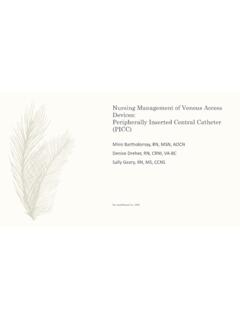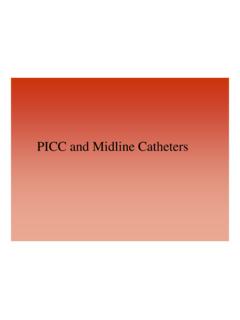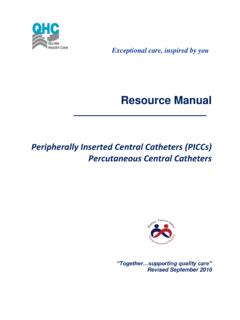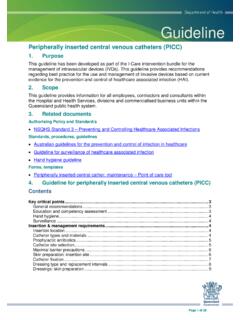Transcription of PICC- Peripherally Inserted Central Catheter
1 PICC- Peripherally Inserted Central Catheter Facility: (Affix identification label here) URN: Family name: Given name(s): Address: Date of birth: Sex: M F I Page 1 of 2 Continues over page - 03/2011 The State of Queensland (Queensland Health), 2011 Permission to reproduce should be sought from DO NOT WRITE IN THIS BINDING MARGIN A. Interpreter / cultural needs An Interpreter Service is required? Yes No If Yes, is a qualified Interpreter present? Yes No A Cultural Support Person is required? Yes No If Yes, is a Cultural Support Person present? Yes No B. Procedure The following will be performed (Doctor/doctor delegate to document include site and/or side where relevant to the procedure) .. Peripherally Inserted Central Catheter (PICC) is a long, narrow tube ( Catheter ) about the same size as a strand of long spaghetti. It is used to give you medication directly into your blood stream without having to repeatedly insert a needle into your vein.
2 Using ultrasound as a guide the needle will be Inserted into your vein. Once the Catheter has entered into your vein, it is passed along the vein using X-ray guidance. The tip of the PICC will be positioned in one of the major blood vessel next to the heart. When the Catheter is in the correct place a chest x-ray will be taken to confirm its placement. This procedure will require the injection of a local anaesthetic. A sedative injection is rarely given. C. Risks of the procedure In recommending the PICC, the doctor believes the benefits to you from having this procedure exceed the risks involved. The risks and complications with this procedure and with having a PICC can include but are not limited to the following. Common risks and complications include: Minor pain, bruising and/or infection at the insertion site. This may require treatment with antibiotics. Bleeding or bruising may occur. This is usually stopped by applying pressure and/or ice to the puncture site.
3 This is more common if you take Aspirin, Warfarin, Clopidogrel (Plavix and Iscover) or Dipyridamole (Persantin and Asasantin). The PICC may become kinked or blocked. The PICC may need to be re-positioned and/ or medication given to unblock the Catheter The PICC may be accidentally removed if pulled or tugged on. The PICC may need to be re- Inserted . Failure of local anaesthetic which may require a further injection of anaesthetic or a different method of anaesthesia may be used. Nerve damage, is usually temporary, and should get better over a period of time. Permanent nerve damage is rare. Less common risks and complications include: Infection at the skin puncture site, requiring antibiotics and/or further treatment. Infection in the Catheter , requiring the removal of the PICC. Damage to surrounding structures such as blood vessels, organs and muscles, requiring further treatment. Irritation and pain in the vein from the PICC, the medications injected or from infection.
4 The PICC may need to be removed. Blood clot blocking the vein may require medication to treat. An allergy to injected drugs, requiring further treatment. Difficulty or inability to advance/insert the PICC may be due to small vessels, vasospasm, stenosis or difficult anatomy. The procedure may not be possible due to medical and/or technical reasons. Rare risks and complications include: Injected medications may leak outside of the vein, under the skin and into the fat tissues, this may require treatment. A fast or irregular heart beat. Usually resolves on it s own but sometimes may need further treatment. The tip of the PICC may move from the original placement, this will require repositioning or removal. An air bubble enters the blood stream. This can travel to the heart causing a heart attack or to the brain causing a stroke. An increased lifetime cancer risk due to the exposure to x-rays. Seizures and/or cardiac arrest due to local anaesthetic toxicity.
5 Death as a result of this procedure is very rare.. PROCEDURAL CONSENT FORM PICC- Peripherally Inserted Central Catheter Facility: (Affix identification label here) URN: Family name: Given name(s): Address: Date of birth: Sex: M F I Page 2 of 2 03/2011 - DO NOT WRITE IN THIS BINDING MARGIN D. Patient consent I acknowledge that the doctor/doctor delegate has explained the proposed procedure. I understand; the risks and complications, including the risks that are specific to me. the anaesthetic required for this procedure. I understand the risks, including the risks that are specific to me. that no guarantee has been made that the procedure will improve my condition even though it has been carried out with due professional care. if immediate life-threatening events happen during the procedure, they will be treated based on my discussions with the doctor/doctor delegate or my Acute Resuscitation Plan.
6 A doctor/doctor delegate undergoing further training may conduct this procedure. I have been given the following Patient Information Sheet/s: PICC- Peripherally Inserted Central Catheter Ultrasound I was able to ask questions and raise concerns with the doctor/doctor delegate about the proposed procedure and its risks. My questions and concerns have been discussed and answered to my satisfaction. I understand I have the right to change my mind at any time including after I have signed this form but, preferably following a discussion with my doctor/doctor delegate. I understand that image/s or video footage may be recorded as part of and during my procedure and that these image/s or video/s will assist the doctor to provide appropriate treatment. I understand that Queensland Health may release my relevant de-identified information obtained from this and related procedures for education and training of health professionals.
7 On the basis of the above statements, I request to have the procedure Name of Patient:.. Signature:.. Date:.. Patients who lack capacity to provide consentConsent must be obtained from a substitute decision maker/s in the order below. Does the patient have an Advance Health Directive (AHD)? Yes Location of the original or certified copy of the AHD: .. No Name of Substitute Decision Maker/s:..Signature:..Relationship to patient:..Date:.. PH No:..Source of decision making authority (tick one): Tribunal-appointed Guardian Attorney/s for health matters under Enduring Power of Attorney or AHD Statutory Health Attorney If none of these, the Adult Guardian has provided consent. Ph 1300 QLD OAG (753 624) E. Doctor/delegate Statement I have explained to the patient all the above points under the Patient Consent section (D) and I am of the opinion that the patient/substitute decision-maker has understood the information.
8 Name of Doctor/delegate:.. Designation:.. Signature:.. F. Interpreter s statement I have given a sight translation in .. (state the patient s language here) of the consent form and assisted in the provision of any verbal and written information given to the patient/parent or guardian/substitute decision-maker by the doctor. Name of Interpreter:.. Signature:.. Consent Information - Patient Copy PICC- Peripherally Inserted Central Catheter Page 1 of 2 Continues over page The State of Queensland (Queensland Health), 2011 Permission to reproduce should be sought from - 1. What is a PICC? Peripherally Inserted Central Catheter (PICC) is a long, narrow tube ( Catheter ) about the same size as a strand of long spaghetti. It is used to give you medication directly into your blood stream without having to repeatedly insert a needle into your vein. Blood samples can also be taken through the PICC for testing.
9 A PICC can be left in place for weeks or months depending on your treatment. This procedure is performed in medical imaging with guidance from imaging machines such as ultrasound and x-ray. For more information on these imaging methods and the risks involved in their use, please read the Ultrasound Patient Information Sheet (if you do not have this information sheet please ask for one). 2. Will there be any discomfort, is any anaesthetic needed? This procedure will require an injection of a local anaesthetic. It is used to prevent or relieve pain, but will not put you to sleep. You should feel no more than mild discomfort. 3. Preparation for the procedure The medical imaging department will give you instructions on how to prepare for your procedure. Please tell the staff if you are or suspect you might be pregnant or are breastfeeding. If you take Aspirin, Warfarin, Clopidogrel (Plavix and Iscover) or Dipyridamole (Persantin and Asasantin) or any other drug that is used to thin your blood ask your doctor/health practitioner if you should stop taking it before the procedure as it may affect your blood clotting.
10 4. During the procedure Ultrasound will be used to look at your veins and a suitable vein for the Catheter will be selected. Local anaesthetic will be injected into the skin around the selected vein. Using ultrasound as a guide the needle will be Inserted into your vein. You must remain as still as possible. Once the Catheter has entered into your vein, it is passed along the vein using X-ray guidance. At this time, you may be asked to turn your head to face the arm where the PICC is being Inserted . This helps guide the Catheter into the right place. The tip of the PICC will be positioned in one of the major blood vessel next to the heart. The Catheter does not go into your heart. You will not feel the Catheter inside your body. When the Catheter is in the correct place a chest x-ray will be taken to confirm its placement. 5. After the procedure At the end of the procedure, a dressing will be applied to your arm where the Catheter exits your vein.
















